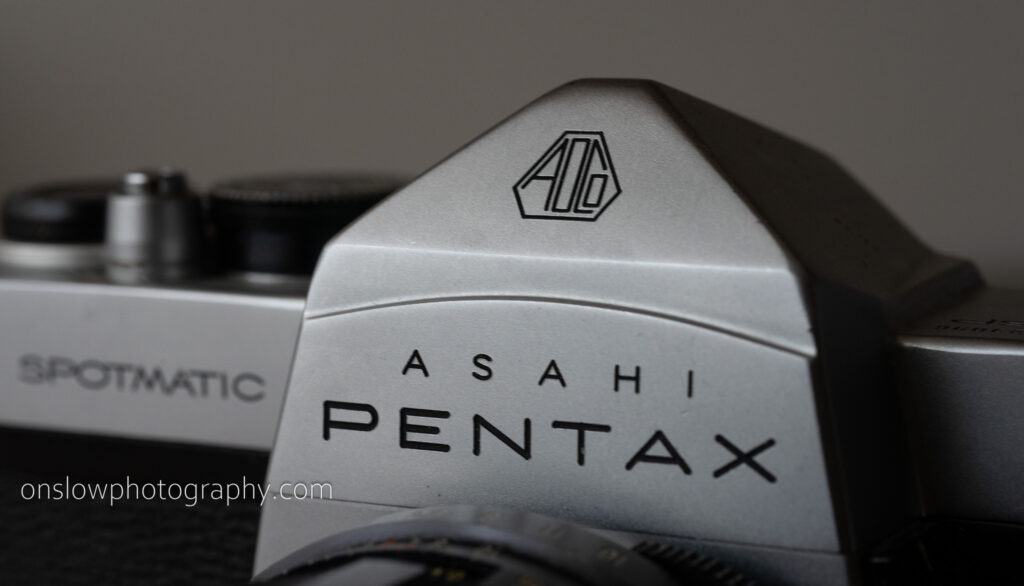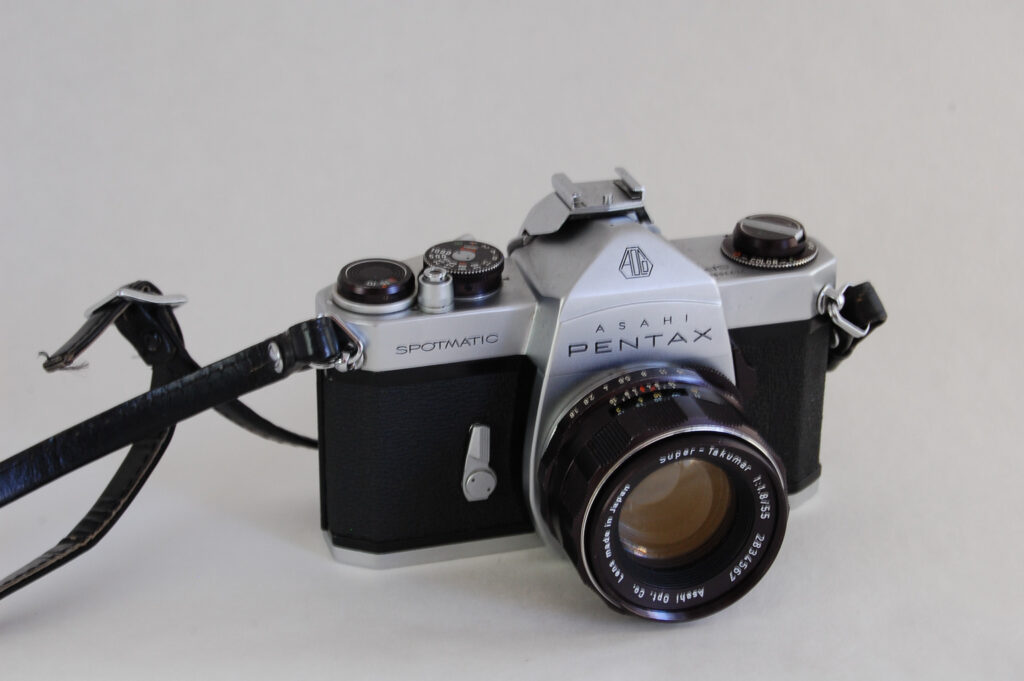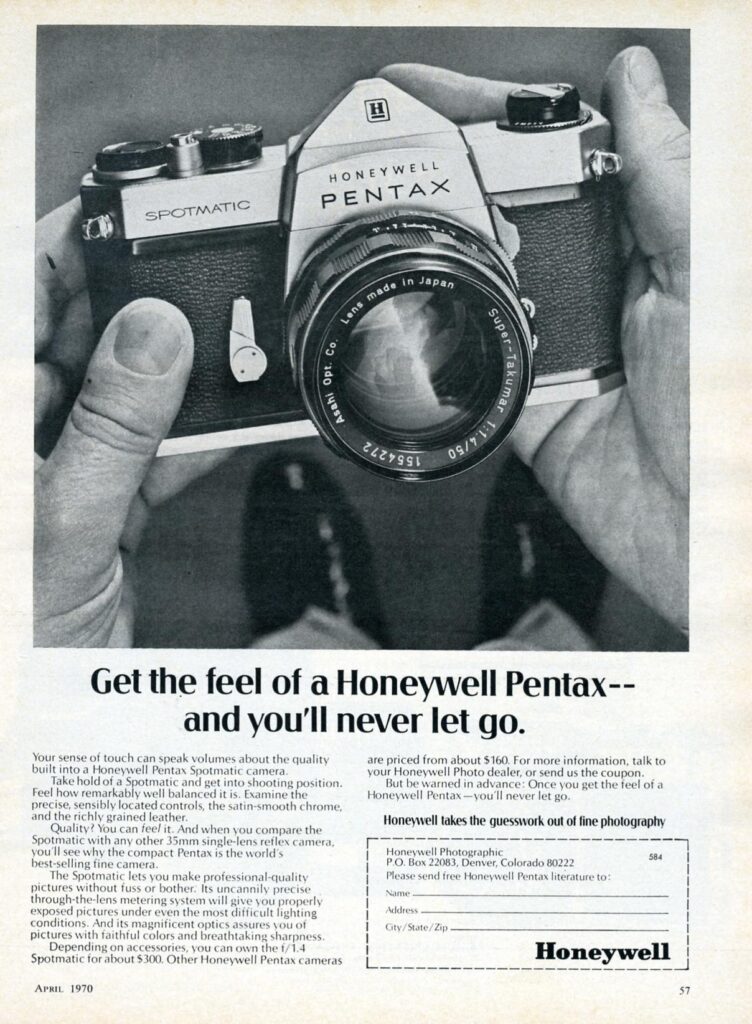Pentax Spotmatic SP

Asahi-Pentax: the brand behind the Spotmatic
The Spotmatic was manufactured by Asahi Optical Co., Ltd. a Japanese company founded in 1919 that became famous under the brand name Asahi-Pentax. Asahi, which initially specialised in the manufacture of eyeglass lenses and precision instruments, expanded into the field of photography, quickly becoming one of the pioneers of 35mm Single-Lens Reflex (SLR) cameras.
In 1952, Asahi introduced the Asahiflex, Japan’s first pentaprism SLR, laying the foundation for the brand’s success. In 1957, with the birth of the Pentax AP, the Pentax brand became synonymous with innovation and quality, leading to the creation of revolutionary models, such as the Spotmatic.
In the United States, Pentax models were initially distributed under the Honeywell Pentax brand, due to a commercial agreement with Honeywell Inc. For this reason, the Spotmatic can be found on the secon-hand market under both the Asahi Pentax brand and the Honeywell Pentax logo, with no major differences between the versions.

Historical context
In 1964, the year the Spotmatic SP was launched, the SLR market was dominated by large and expensive models such as the Nikon F Photomic, which at the time did not yet feature TTL metering and was bulkier and heavier (over 200 grams more). The Spotmatic, by contrast, was more compact and ergonomic, offering excellent build quality and an attractive design.
It is often read that the Pentax Spotmatic was the first SLR in the world to feature Through The Lens (TTL) exposure metering. However, this claim is inaccurate; in fact, the record belongs to the Topcon RE Super, introduced in 1963. What makes the Spotmatic special is that it was the first SLR with TTL exposure metering to achieve widespread commercial success, thanks to its compact design, ease of use, and solid construction.
It was this combination of technological innovation, practicality and competitive price that led to its success, turning it into one of the most beloved cameras of its era.
Technical characteristics of the Pentax Spotmatic SP
The Spotmatic SP boasted advanced features for the period:
- Shutter speeds: 1 second to 1/1000s
- Weight: 620 grams (body only)
- Exposure meter: CdS with TTL stop-down metering, sensitivity from ISO 20 to 1600
- Focusing: with microprisms on the focusing screen
- Flash sync: 1/60s, with attachment via removable accessory shoe
- Integrated self-timer
- Power supply: 1.35V mercury battery (no longer commercially available today, but usable with 1.5V silver oxide battery adapters)

Although the name might suggest otherwise, the Spotmatic did not offer true spot metering, but rather a center-weighted average metering. This misunderstanding probably stems from the term “Spot”, which Pentax actually used to emphasise the accuracy of TTL readout compared to traditional systems of the time.
The User Experience: A Journey into the Past
Using the Spotmatic today means embarking on a genuine time-travel adventure. It offers an educational experience that compels the photographer to deeply grasp the fundamental principles of photography, at a time when modern cameras and smartphones often obscure these concepts with an array of automated functions.
One of the distinctive aspects of the Spotmatic is its stop-down metering system. Since M42-mount lenses did not transmit the set aperture information to the camera body, it was necessary to manually stop down the lens to the selected value before obtaining the meter reading.

An interesting detail of using the Spotmatic is the lever located on the front side of the camera, easily operated with the left hand. This lever not only activates the exposure meter circuit, but also stops down the lens to the pre-set aperture, enabling real-time exposure measurement. When the shutter is released, the lever automatically disengages, turning off the meter and restoring the maximum aperture for a clear viewfinder image.
Although this system is less convenient than later models with open-aperture metering, it is highly instructive, as it forces the user to carefully assess both exposure and depth of field before taking a shot.
One of the great advantages of the Spotmatic today is the vast availability of M42 screw-mount lenses, which can be found at excellent prices on the second-hand market. In addition to Pentax, companies such as Carl Zeiss, Yashica, Fujinon, Helios, and Chinon also produced M42-mount lenses, making this system a de facto standard in its days.
The legacy of the Spotmatic.
The Spotmatic SP was not an isolated case, but the forerunner of a series of improved models, including the Spotmatic SPII, SP500, SP1000 and Spotmatic F, the latter featuring open aperture metering.
Today, the Spotmatic is still highly sought after by collectors and analog photography enthusiasts. With the wide availability of high-quality M42 lenses, its robust design and affordable price, it is an excellent choice for those who want to rediscover the charm of shooting on film.
Further reading
- Camerapedia: detailed fact sheet with several useful links,
- Photoethnography: in-depth article on the Pentax Spotmatic,
- Todd Gustavson, 500 Cameras: 170 Years of Photographic Innovation, p. 271, published by Sterling Signature
- How The Beatles helped turn the Pentax Spotmatic into an iconic camera, an article by Paul Borrows, on Digital Camera World